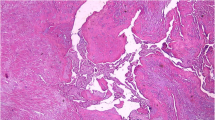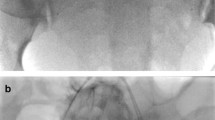Abstract
Objectives
The aim of the study was to identify the risk factors predisposing to morbidly adherent placenta and to study the different modes of management and the obstetric and neonatal outcome of these patients.
Methods
This was a retrospective cum prospective observational study conducted in the Department of Obstetrics and Gynaecology in a tertiary care referral hospital in Mumbai from January 2012 to November 2014.
Results
The incidence of morbidly adherent placenta was 1.32 per 1000 pregnancies with patient profile comprising second gravida in the age group 26–28 years; 90 % of the patients in this study had previous Caesarean section and co-existing placenta praevia was diagnosed in 63 %. Fifty-three per cent of the women delivered between 35 and 38 weeks and 40 % had elective deliveries. Caesarean section was the mode of delivery in 90 % of the patients. Prophylactic balloon placement in the internal iliac artery followed by classical Caesarean section, uterine artery embolization and post-operative methotrexate was done in 27 % which preserved the uterus and was associated the blood loss of 1000–2000 mL.
Conclusion
Antenatal diagnosis of morbidly adherent placenta allows for multidisciplinary planning in an attempt to minimize potential maternal or neonatal morbidity and mortality.




Similar content being viewed by others
References
Bajwa SK, Singh ABS. Contemporary issues in the management of abnormal placentation during pregnancy in developing nations: an Indian perspective. Int J Crit Illn Inj Sci. 2013;3(3):183–9.
Bauer ST, Bonanno C. Abnormal placentation. Semin Perinatol. 2009;33(2):88–96.
Yi KW, Oh M-J, Seo T-S, et al. Prophylactic hypogastric artery ballooning in a patient with complete placenta previa and increta. J Korean Med Sci. 2010;25(4):651–5.
Hamilton BE, Martin JA, Ventura SJ, et al. Births: preliminary data for 2004. Natl Vital Stat Rep. 2005;54(8):1–17.
Jagielska I, Kazdepka-Ziemińska A, Tyloch M, et al. Clinical study of perinatal hysterectomy between 2000-2011 in the clinic of obstetrics, gynecological diseases and oncological gynecology in Bydgoszcz. Ginekol Pol. 2014;85(3):192–6.
Dandolu V, Graul AB, Lyons AMD. Obstetrical hysterectomy, cesarean delivery and abnormal placentation. J Matern Fetal Med. 2012;25(1):74–7.
Roethlisberger M, Womastek I, Posch M, et al. Early postpartum hysterectomy: incidence and risk factors. Acta Obs Gynecol Scand. 2010;89(8):1040–4.
Eller AG, Porter TF, Soisson P, et al. Optimal management strategies for placenta accreta. BJOG. 2009;116(5):648–54.
Sumigama S, Itakura A, Ota T, et al. Placenta previa increta/percreta in Japan: a retrospective study of ultrasound findings, management and clinical course. J Obstet Gynaecol Res. 2007;33(5):606–11.
Tikkanen M, Paavonen J, Loukovaara MSV. Antenatal diagnosis of placenta accreta leads to reduced blood loss. Acta Obs Gynecol Scand. 2011;90(10):1140–6.
Bennett MJSR. “Conservative” management of placenta praevia percreta: report of two cases and discussion of current management options. Aust N Z J Obs Gynaecol. 2003;43:249–51.
Aggarwal R, Suneja A, Vaid NB, et al. Morbidly adherent placenta: a critical review. J Obstet Gynaecol India. 2012;62(1):57–61. doi:10.1007/s13224-012-0149-5.
Obajimi GO, Roberts AO, Aimakhu CO, et al. An appraisal of retained placentae in ibadan: a five year review. Ann Ibadan Postgrad Med. 2009;7(1):21–5.
Wu S, Kocherginsky MHJ. Abnormal placentation: twenty-year analysis. Am J Obs Gynecol. 2005;192(5):1458–61.
Garmi G, Salim R. Epidemiology, etiology, diagnosis, and management of placenta accreta. Obstet Gynecol Int. 2012;2012:873929.
Armstrong CA, Harding S, Matthews T, et al. Is placenta accreta catching up with us? Aust N Z J Obstet Gynaecol. 2004;44(3):210–3.
Herath R, Wijesinghe P. Management of morbidly adherent placenta. Sri Lanka J Obstet Gynaecol. 2012;33(2):39–44.
Suwannarurk K, Thaweekul Y, Mairaing K, et al. Silent abnormal placentation linkage to peripartum hysterectomy: Thammasat University Hospital 6-year study. J Med Assoc Thai. 2014;97(5):473–7.
El-Messidi A, Mallozzi AOL. A multidisciplinary checklist for management of suspected placenta accreta. J Obs Gynaecol Can. 2012;34(4):320–4.
Belfort M. Indicated preterm birth for placenta accreta. Semin Perinatol. 2011;35(5):252–6.
Chandraharan E, Rao S, Belli AMAS. The Triple-P procedure as a conservative surgical alternative to peripartum hysterectomy forplacenta percreta. Int J Gynaecol Obs. 2012;117(2):191–4.
Allahdin S, Voigt S, Htwe TT. Management of placenta praevia and accreta. J Obstet Gynaecol. 2011;31(1):1–6.
Tan CH, Tay KH, Sheah K, et al. Perioperative endovascular internal iliac artery occlusion balloon placement in management of placenta accreta. AJR Am J Roentgenol. 2007;189(5):1158–63.
Dasari P, Venkatesan B, Thyagarajan C, et al. Expectant and medical management of placenta increta in a primiparous woman presenting with postpartum haemorrhage: the role of imaging. J Radiol Case Rep. 2010;4(5):32–40.
Breathnach F, Tuite DJ, McEniff N, et al. Uterine artery embolisation as an interval adjunct to conservative management of placenta praevia increta. J Obstet Gynaecol. 2007;27(2):195.
Hayes E, Ayida G, Crocker A. The morbidly adherent placenta: diagnosis and management options. Curr Opin Obstet Gynecol. 2011;23(6):448–53.
Acknowledgments
There was no funding involved in this study.
Author information
Authors and Affiliations
Corresponding author
Ethics declarations
Conflict of interest
All authors declare that they have no conflict of interest.
Ethical Approval
All procedures performed in studies involving human participants were in accordance with the ethical standards of the institutional and/or national research committee and with the 1964 Helsinki Declaration and its later amendments or comparable ethical standards.
Informed Consent
Informed consent was obtained from all individual participants included in the study.
Additional information
Dr. H. K. Chaudhari is an Associate Professor in Department of Obstetrics and Gynaecology at Seth G. S. Medical college and K.E.M. Hospital, Mumbai; Dr. P. K. Shah is a Professor in Department of Obstetrics and Gynaecology at Seth G. S. Medical College and K.E.M. Hospital, Mumbai; Dr. Natasha D'Souza is a Resident in Department of Obstetrics and Gynaecology at Seth G. S. Medical College and K.E.M. Hospital, Mumbai.
Rights and permissions
About this article
Cite this article
Chaudhari, H.K., Shah, P.K. & D’Souza, N. Morbidly Adherent Placenta: Its Management and Maternal and Perinatal Outcome. J Obstet Gynecol India 67, 42–47 (2017). https://doi.org/10.1007/s13224-016-0923-x
Received:
Accepted:
Published:
Issue Date:
DOI: https://doi.org/10.1007/s13224-016-0923-x




